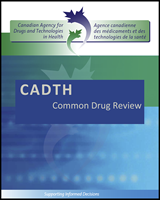1.1. Disease Prevalence and Incidence
Overactive bladder (OAB) is a chronic condition of the lower urinary tract defined by the International Continence Society as a syndrome experienced during the storage phase of the bladder. It is characterized by symptoms of urinary urgency, with or without urge incontinence, usually with increased daytime frequency and nocturia in the absence of other obvious pathology.2–5
It is estimated that OAB affects 14% to 18% of Canadians.6–8 OAB symptom prevalence tends to increase with age (12.2% for < 60 years old versus 23.8% for > 60 years old).8 Similar OAB prevalence among men and women has been reported in some studies; however, OAB with urge incontinence is more frequently reported in women than men (7.1% versus 3.3%).8 A true incidence measure of OAB is difficult as many patients are embarrassed to discuss their symptoms with their physician or feel that OAB is a normal part of aging and must be accepted.9,10 OAB is therefore a condition that often remains underdiagnosed.10
OAB may affect an individual’s psychological and social well-being by leaving sufferers feeling anxious, frustrated, and embarrassed.9 OAB has been linked to higher levels of depression, higher levels of work impairment (e.g., absenteeism, presenteeism, decreased productivity), and greater rates of unemployment.11 Even mild symptoms of urinary incontinence have the potential to affect patient quality of life by having a negative impact on everyday participation in a variety of interpersonal, professional, and social activities.9
1.2. Standards of Therapy
According to the Canadian Urological Association Guidelines (CUAG),6 it is recommended that behavioural and lifestyle modification be implemented first for the treatment of urinary incontinence. Pharmacological therapies are also used in OAB patients who do not achieve symptom relief with conservative management. Anticholinergic drugs are commonly used in OAB patients; treatment options include darifenacin, fesoterodine, oxybutynin, solifenacin, tolterodine, and trospium.6 A recent systematic review and meta-analysis showed that these medications had comparable benefits and tolerability, with clinically minor differences between drugs.12 The main safety concerns with these drugs include anticholinergic adverse effects, such as dry mouth, dizziness, blurred vision, constipation, urinary retention, cognitive disorders, confusion, and drowsiness. Anticholinergic drugs are contraindicated in patients with uncontrolled narrow-angle glaucoma, gastric retention, and those at risk for urinary retention. Canadian guidelines state that the choice of anticholinergic agent may depend on physician experience and preference, formulary coverage, patient preference, and insurance coverage.6 Mirabegron, a selective beta 3 agonist recently approved by Health Canada, may be an alternative for patients who have contraindications to or are intolerant of anticholinergic medications. It is estimated that three-quarters of patients will be successfully treated with behavioural and/or drug therapy.13
According to the American Urological Association and the Society of Urodynamics, Female Pelvic Medicine and Urogenital Reconstruction guidelines,14 pharmacological therapies, including oral beta 3 agonist or anticholinergic, should be offered as second-line therapy to patients with non-neurogenic OAB who are unable or unwilling to comply with behavioural therapy.
According to CUAG, patients who have failed two or more adequate treatments of anticholinergic drugs are considered to have refractory urge incontinence.6
Sacral neuromodulation and percutaneous tibial nerve stimulation are treatment options for refractory urge incontinence, with a response rate that ranges from 39% to 81%; however, these therapies are expensive and not widely available or accessible.6
1.3. Drug
OnabotulinumtoxinA (Ona A) is a purified neurotoxin complex produced from the fermentation of Clostridium botulinum type A. 15 This CADTH Common Drug Review (CDR) submission is specific to the approved Health Canada indication for the treatment of (non-neurogenic) OAB with symptoms of urinary incontinence, urgency, and frequency, in adult patients who have an inadequate response to or are intolerant of anticholinergic medication.15 The recommended dose is 100 U, administered via injections into the detrusor muscle across 20 sites of the bladder. Patients may be considered for re-treatment no sooner than three months after prior bladder injection, when the clinical effect of the previous injection diminishes.15 Ona A affects the efferent pathways of detrusor activity by inhibiting the release of acetylcholine following intradetrusor injections.
View in own window
| Indication under review |
|---|
| For the treatment of overactive bladder with symptoms of urinary incontinence, urgency, and frequency, in adult patients who have an inadequate response to or are intolerant of anticholinergic medication. |
| Listing criteria requested by sponsor |
|---|
| For the treatment of refractory urinary incontinence due to overactive bladder. |

